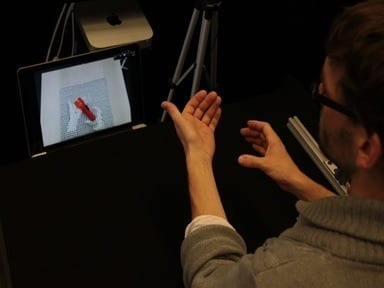
MIT researchers find a way to boost lithium-air battery performance, with the help of modified viruses.
MIT researchers have found a way to boost lithium-air battery performance, with the help of modified viruses.
Lithium-air batteries have become a hot research area in recent years: They hold the promise of drastically increasing power per battery weight, which could lead, for example, to electric cars with a much greater driving range. But bringing that promise to reality has faced a number of challenges, including the need to develop better, more durable materials for the batteries’ electrodes and improving the number of charging-discharging cycles the batteries can withstand.
Now, MIT researchers have found that adding genetically modified viruses to the production of nanowires — wires that are about the width of a red blood cell, and which can serve as one of a battery’s electrodes — could help solve some of these problems.
The new work is described in a paper published in the journal Nature Communications, co-authored by graduate student Dahyun Oh, professors Angela Belcher and Yang Shao-Horn, and three others. The key to their work was to increase the surface area of the wire, thus increasing the area where electrochemical activity takes place during charging or discharging of the battery.
The researchers produced an array of nanowires, each about 80 nanometers across, using a genetically modified virus called M13, which can capture molecules of metals from water and bind them into structural shapes. In this case, wires of manganese oxide — a “favorite material” for a lithium-air battery’s cathode, Belcher says — were actually made by the viruses. But unlike wires “grown” through conventional chemical methods, these virus-built nanowires have a rough, spiky surface, which dramatically increases their surface area.
Belcher, the W.M. Keck Professor of Energy and a member of MIT’s Koch Institute for Integrative Cancer Research, explains that this process of biosynthesis is “really similar to how an abalone grows its shell” — in that case, by collecting calcium from seawater and depositing it into a solid, linked structure.
The increase in surface area produced by this method can provide “a big advantage,” Belcher says, in lithium-air batteries’ rate of charging and discharging. But the process also has other potential advantages, she says: Unlike conventional fabrication methods, which involve energy-intensive high temperatures and hazardous chemicals, this process can be carried out at room temperature using a water-based process.
Also, rather than isolated wires, the viruses naturally produce a three-dimensional structure of cross-linked wires, which provides greater stability for an electrode.
A final part of the process is the addition of a small amount of a metal, such as palladium, which greatly increases the electrical conductivity of the nanowires and allows them to catalyze reactions that take place during charging and discharging. Other groups have tried to produce such batteries using pure or highly concentrated metals as the electrodes, but this new process drastically lowers how much of the expensive material is needed.
Altogether, these modifications have the potential to produce a battery that could provide two to three times greater energy density — the amount of energy that can be stored for a given weight — than today’s best lithium-ion batteries, a closely related technology that is today’s top contender, the researchers say.
Belcher emphasizes that this is early-stage research, and much more work is needed to produce a lithium-air battery that’s viable for commercial production.
Go deeper with Bing News on:
Lithium-air battery
- Lithium-ion battery fire breaks out in back of Cornwall bin lorry
Cornwall officials have urged people to properly dispose of batteries after a blaze broke out in a bin lorry near Penzance. Flames and smoke burst from the back of a waste disposal vehicle while crews ...
- U.S. EV battery upstart, Hyundai-Kia close in on lithium metal battery commercialization
SES AI, a U.S. maker of electric vehicle batteries, aims to bring its next-gen lithium metal batteries to market as early as 2026 and is turbocharging the drive through a new agreement to jointly ...
- A Cheaper and More Sustainable Lithium Battery: How LiDFOB Could Change Everything
Scientists have developed an ultralow-concentration electrolyte for lithium-ion batteries. Lithium salts enhance the power of batteries but also increase their cost. A new electrolyte with a very low ...
- Building the Battery That Could Save the Planet
According to Elon Musk, “lithium batteries are the new oil,” and he might be right. From powering our phones to driving the future of electric vehicles, batteries are more crucial ...
- Beyond Lithium: What Will the Next Generation of Batteries Be Made Of?
Lithium-ion batteries have taken up permanent residence in our homes for years now. They're hidden in your phone and laptop, but they might also lurk in your electric toothbrush or your bike. Even ...
Go deeper with Google Headlines on:
Lithium-air battery
[google_news title=”” keyword=”lithium-air battery” num_posts=”5″ blurb_length=”0″ show_thumb=”left”]
Go deeper with Bing News on:
Next generation battery
- Daimler Buses and battery systems expert BMZ Poland partner for next-gen electric bus batteries
Daimler Buses and battery systems expert BMZ Poland, a key entity in the BMZ Holding group, have entered into a strategic partnership for the development and supply of the next generation of electric ...
- Apple is working to improve battery life on next-generation smartwatches
The Apple Watch X is rumored to introduce a blood pressure monitor that can alert users to high or low readings. This addition highlights Apple's ongoing commitment to integrating advanced health ...
- Schneider Electric Unveils Next-Gen Battery Energy Storage System for Microgrids
Schneider Electric introduces its latest Battery Energy Storage System (BESS), designed to enhance energy resilience and sustainability within mi ...
- Mercedes Reveals EV G-Class, But It's Still Working on Those Next-Gen Batteries
The G-Class offers stellar horsepower and performance but the first version will not have the revolutionary silicon battery the brand promised would be in the G-Wagen by 'mid-decade.' ...
- Hithium Hosts Roundtable at the BNEF Summit New York, Discussing Next Generation Battery Energy Storage System
From April 16th to 17th, the BloombergNEF (BNEF) Summit was held in New York, USA. The BNEF Summit brings together energy, finance, and technology professionals to facilitate the exchange of ideas, ...
Go deeper with Google Headlines on:
Next generation battery
[google_news title=”” keyword=”next generation battery” num_posts=”5″ blurb_length=”0″ show_thumb=”left”]










